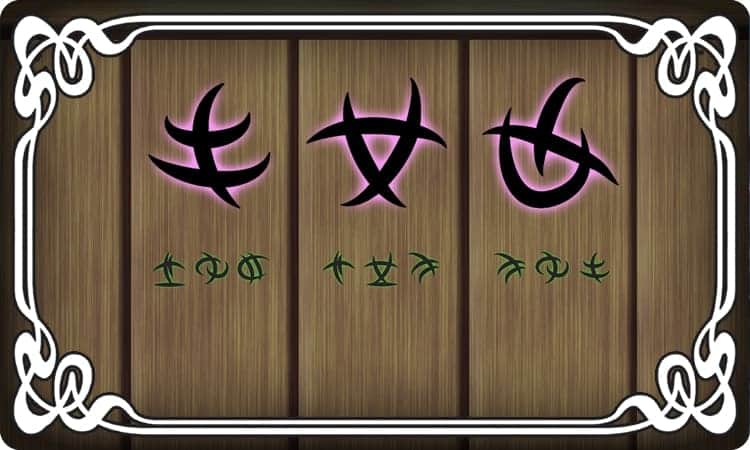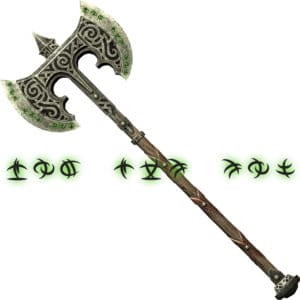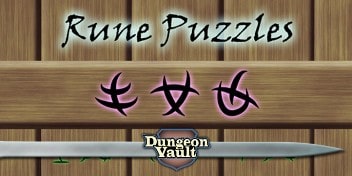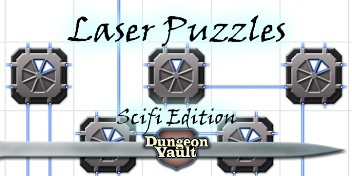
Puzzles have long since been a staple of role-playing games like Dungeons & Dragons. And Door Puzzles are special for their ability to seal off rooms, treasure chests, or even lock magical items.
For those of you looking for a quick free D&D door puzzle, scroll to the bottom of this article. There you will find two free door puzzles you can drop into any game. But if you want to learn how to design a great door puzzle yourself or use puzzles more effectively, read on.
So how do you design a good D&D door puzzle? As a game designer I have created hundreds of door puzzles. (It’s a hobby, stop judging me.) But in order to design a good door puzzle we first have to focus on a myriad of problems that come with door puzzle design. In this illustrated guide, we will look at all the major problems associated with creating door puzzles from a game designer’s perspective, and how to solve them.
Updated on 10-09-2023
Avoid Getting Stuck

If door puzzles are not easy to solve, PCs risk getting stuck and unable to open a door. This might bring your game to a grinding halt. To make sure that doesn’t happen, D&D door puzzles should be easy to solve. On the other hand, you don’t want your puzzles to be too easy.
So how do we fix this problem? Create a puzzle that involves many steps which are all relatively easy to solve. While it might take your players some time to figure out all the steps, it is almost guaranteed that they will solve the door puzzle in the end. This way they get that sense of accomplishment, without the frustration of not being able to open the door.

For instance, I’ve created a D&D door puzzles called ‘Rune Puzzles’. It incorporates several steps players must solve in order to find the solution. But each step is relatively easy to solve. The steps are:
- Translate the runes.
- Solve the anagram.
- Find to cryptic meaning.
- Find the object to touch the door.
When designing a puzzle I like to start at the end and work my way backwards. This way I can keep adding extra steps easily. So for rune puzzles I thought of an object PCs would probably carry with them or could find in a dungeon. Next, I thought of a cryptic description for that item. Then, I created an anagram. And finally, I translated the anagram into runes. All easy steps to create (and solve) but it takes some doing.

If players still get stuck, offer them some other way to open the door at cost. For instance, they might be able to break the door down, alerting the guards. Just because we as creators spend all this time designing a puzzle, doesn’t mean to players have to solve it. It can be frustrating because of all the work you’ve put into your puzzle, but players should always have the freedom to follow a different path.
Create a Cooperative Experience
Having more steps to a door puzzle also ensures cooperation. Players can share and build on successes of fellow party members. It also helps to place a visual puzzle at the centre of the table so everyone can participate.
You can adapt your door puzzle designs to take into account that players at a table are all viewing the puzzle from a different direction. While not a problem for VTT, players at a table should all be able to join in no matter from what angle they are viewing the puzzle. Here’s an example of a door puzzle I created that can be solved no matter from what direction players are looking at it:

Another great way to stimulate collaboration is to divide clues and key pieces among players. They can only solve the puzzle by sharing what they have found. For instance, with the rune puzzle each player could uncover some of the runes needed to solve the puzzle.
Another thing you can do is to spread the lock of a door puzzle out over a greater area. PCs might have to place or turn a key piece simultaneously for a door te open. And forcing the party to split up this way, could impose other challenges.
Challenge the Players and Their Characters
The critique I’ve most heard about using puzzles in Dungeons and Dragons is that puzzles challenge the players and not their characters. But the best puzzles challenge both the players and their characters.
You can challenge the characters by having them uncover all the clues and key pieces to the door puzzle. They can:
- Roll to search a room.
- Use a divination spell.
- Fight a monster and find a clue in its treasure hoard.
- Research an ancient library.
- Interrogate an NPC.
All of these challenge the character. Only solving the puzzle itself challenges the player. And even then you can reward players who roll a successful intelligence check with minor hints.
Of course, sometimes puzzles don’t have key pieces such as a Sudoku puzzle. These puzzles are therefore less optimal for using as door puzzles. They only challenge the players not their characters. That doesn’t mean these types of puzzles can’t ever be used. The free D&D door puzzles at the end of this article don’t use key pieces and work just fine. But it’s something to consider when designing your door puzzle.
Create an Immersive D&D Door Puzzle
Another common critique is that door puzzles can feel contrived. Do NOT just stick a sudoku to a door and call it an immersive puzzle. And by the Gods resist the temptation to have PCs unravel your christmas lights! While extremely convienent, also NOT a door puzzle.
Instead ask yourself: Why would anyone place a magical or mechanical puzzle on a door? The best D&D door puzzles feel as a natural part of the world. There should be a perfectly logical reason for the puzzle being there.
Door puzzles are put there to filter out those who can solve the puzzle from those who cannot. For instance, the rune puzzle might be placed on a door by a wizard as a test of intelligence for other wizards who wish to uncover arcane secrets. Or it could be some form of celestial that only good characters can speak out loud. Maybe it is not meant as a puzzle at all but part of an alien language. However outlandish the reason, it must be a natural part of your fantastical gaming world.
When we challenge the players they often feel less connected to the story and that characters. This especially happens when they go into puzzle solving mode. One way to enhance or improve the game immersion, is to introduce time pressure and to make opening the door important to the characters. For instance, instead of just solving the rune door puzzle a character could hear the cries of his loved ones from behind the door slowly dying away. The ongoing drama will keep players in-character and creates a sense of urgency.
And also, door puzzles do not necessarily have to be placed onto doors. You can place a door puzzle onto any object that you can unseal. Be it an ancient tomb or a magical sword.
Finally, the easiest way to create immersion in the game is to provide players with physical clues they can touch and manipulate. Sharing and investigating physical puzzle pieces also helps create a more cooperative game. This way, puzzles are an ideal vehicle for improving immersion.
Layering D&D Door Puzzles
If you are using a single door puzzle in a dungeon, it’s relatively easy to keep track of all the key pieces you’ll need to plant around the area for players to find. But when you are using ten door puzzles, and each has a different set of key pieces to keep track of, things can get pretty complicated fast.
That’s especially true if you plan to allow PCs to only open your D&D door puzzles in sequence. Here are some helpful steps for layering your door puzzles.
Step 1. Define areas in your dungeon
The first step is to define a number of areas in your dungeon equal to the number of puzzle you want to use.

Step 2. Define the order of exploration
Next, define in which order you want PCs to be able to unlock each area. Obviously, the first room(s) PCs enter should be the first area. It should contain all the key puzzles pieces and clues to enter the second area.
If an area has only one door leading to it, you can simply place a puzzle on that door. But if there a multiple doors leading to an area, you can place the same puzzle on each of those doors. This way, PCs must alway bypass the puzzle no matter how they will try to get in.
Now, the areas do not have to be laid out in a linear way on the map, but the order in which they can be explored is linear. That’s why it is easier to number your areas before you start planting clues. For instance, Let’s say PCs enter the map in the yellow area and your order of exploration is:
Yellow
Red
Orange
Green
Blue

Step 3. Place the key pieces and clues
From the yellow area you place a door puzzle on the door leading to the red area. All the key pieces and clues for solving the puzzle should be in the yellow area.
The next area PCs can explore is the orange area. All key pieces and clues for this area must be placed in the yellow and red area.
Next, PCs explore the green area. Since there are two doorways leading to this area, place the same puzzle on each door. Key pieces and clues must be located in the yellow, red and orange area. Be sure to place at least one key piece in the orange area. Otherwise PCs will be able to open the green area before exploring the orange area.
Finally, spread out key pieces for entering the blue area among the yellow, red, orange, and green areas.
Layering D&D door puzzles to unlock areas in sequence is a very effective way of ensuring PCs explore your entire dungeon. But an area doesn’t always have to be a room. You can step up your game by defining treasure chests and other retainers as areas.
Using this area approach created a path or line for players to follow. You can lay out your storyline along this path. This way, a dungeon will feel like it’s open territory to explore the players while it’s secretly very linear and easy for you to control.
D&D Door Puzzle Summary
Here’s a quick checklist of things to consider when designing a door puzzle. You absolutely do not have to follow all of these. Just be aware of how you choices will affect gameplay.
- Easy to solve
- Create many steps
- Start designing at the end
- Create a visual puzzle
- Create key pieces and clues
- Make players work together
- Incorporate skill and ability checks
- Bypass the puzzle at cost
- Have a logical reason for why the door is locked by a puzzle
- Create urgency
- Make opening the door matter to the PCs
- Layer door puzzles
- Let the D&D story flow with the path of doors
Door Puzzles for Your Game
Door puzzles are really a type of lock puzzles DnD applied specifically to doors. And in a survey among 1.000+ D&D players about which type of puzzle they like most, lock puzzles ranked number one by an overwhelming margin.
It’s better to spread out a number of puzzles then just having one difficult puzzle for players to get stuck on. But creating even one puzzle is a lot of work, let alone creating a whole bunch of them. Here are five type of door puzzles you can use:
Each rune puzzle is a single image you can drop onto a door, treasure chest or magical weapon instantly. This pack contains 30 rune puzzles for your game and an easy formula for creating more puzzles.
With just nine basic puzzles, you can create over 500 unique door puzzles for your players to solve. You can get a great amount of reuse out of this puzzle. Solving these types of puzzles is very intuitive so you don’t need any clues.
These puzzles are single images you can lay out on the floor of your dungeon. There are no key pieces. Players must walk the correct pattern over the floor tiles to unlock the door. This makes them very easy to lay out on the fly.
This puzzle represents a broken door mechanism on your spaceship doors. PCs must fix the laser beams to open the door.
With this puzzle players need to place symmetrically looking plates into a door lock which is a lot harder than it sounds.

Free D&D Door Puzzles
As promised, here are two free door puzzles for your convenience. Just right-click on the image and download it for your personal use.
The heroes start out by locating the two letters T on the door. Next, they draw a straight line between the T’s. The character that sits exactly between the letters, is the next letter in the word. From there the heroes must find its twin character and find which letter is exactly halfway in between those, and so on. The answer to this puzzle is THRESHOLD.
The answer to the puzzles below is FIRSTBORN. This time players have to figure out themselves which letter comes first.

Right now you’re probably thinking: “Wow Paul, that’s amazing! How ever can I repay your extraordinary kindness and generosity for these gifts you have bestowed upon me?”
And then I say: “Stop it, stop it (continue) No really, stop it. Simply liking this article, or even better, sharing it on facebook is more than enough thanks.”
As always, have fun!
By Paul Camp








